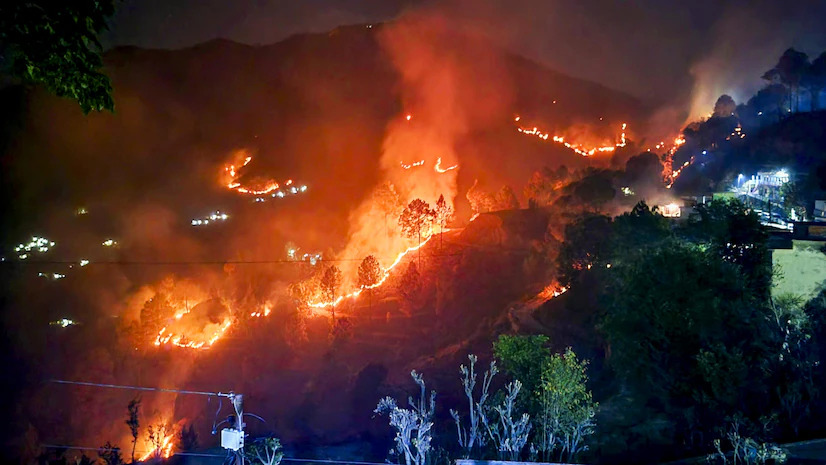What Causes Forest Fires & How Often in India?
Higher forest fire incidents are reported in India during March, April, and May, due to the ample availability of dry biomass following the end of winter and the prevailing summer season.
Amid forest fires in Uttarakhand’s Nainital district, the Indian Air Force was engaged in firefighting operations on Sunday (April 28), the second day the fires continued raging.
According to PTI, which quoted forest officials, the Nainital, Haldwani, and Ramnagar forest divisions were worst affected. In some regions, the fires were doused with the help of a Bambi bucket, used to pour large amounts of water on the flames in relatively quick intervals.
While the exact cause of these fires is unknown, here is a quick recall of the potential causes of forest fires in general, and the factors that impact their frequency and intensity.
How frequent are forest fires in India?
The forest fire season in India lasts between November to June. Factors like temperatures, precipitation, vegetation, and moisture contribute to the scale and frequency of these fires.
According to experts, three factors cause the spread of forest fires — fuel load, oxygen, and temperature. Dry leaves are fuel for forest fires. The Forest Survey of India (FSI) website states that nearly 36% of India’s forests are prone to frequent fires.
Higher fire incidents are reported in March, April and May due to ample availability of dry biomass following the end of winter and amid the prevailing summer season.
The FSI website adds: “Severe fires occur in many forest types parched deciduous forest, while evergreen, semi-evergreen and montane temperate forests are comparatively less prone (India State of Forest Report 2015)… Nearly 4% of the country’s forest cover is extremely prone to fire, whereas 6% is very highly fire-prone (ISFR 2019).”
An FSI analysis in ISFR 2021 also found that states in northeastern India showed the highest tendency for forest fires. Parts of western Maharashtra, southern Chhattisgarh, central Odisha, and regions in Andhra Pradesh, Telangana, and Karnataka also showed patches of extremely and very highly fire-prone zones.
What are some of the causes behind forest fires?
Most fires are believed to be man-made, due to changes in agriculture and unchecked land-use patterns.
The forest department has previously cited four causes of wildfires in Uttarakhand – deliberate fires by locals, carelessness, farming-related activities, and natural reasons. According to a government report, locals set forests on fire for the growth of good quality grass, to cover up illegal cutting of trees, for poaching, etc.
Friction of electricity cables with dry leaves also triggers wildfires, as does lightning, according to the report.
Notably, setting a forest on fire is a punishable offense under the Indian Penal Code. A forest official said several cases have been lodged but the accused remain unidentified in most such cases.
How are forest fires prevented and doused?
The Ministry of Environment, Forest and Climate Change (MoEFCC) lists the following methods to prevent and control a forest fire: construction of watch towers for early detection; deployment of fire watchers; involvement of local communities, and the creation and maintenance of fire lines.
According to the National Disaster Management Authority (NDMA) website, two types of fire lines are in practice – Kachha or covered fire lines, and Pucca or open fire lines. In Kaccha fire lines, the undergrowth and shrubs are removed while trees are retained to decrease the fuel load.
The Pucca fire lines are clear felled areas separating a forest/compartment/block from another to control the spread of potential fires.
The FSI website says: “Satellite-based remote sensing technology and GIS tools have been effective in better prevention and management of fires through the creation of early warning for fire-prone areas, monitoring fires on real-time basis and estimation of burnt scars.”
